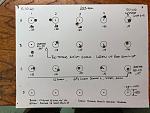After reading this article posted to this site several years ago; https://www.accurateshooter.com/tech...torque-tuning/ I've been performing this tuning technique on my and some fellow shooters rifles with good success. But I've never attempted to quantify the results of my efforts until recently.
The target below is a series of 10 rings with aiming dot. Shooting one round per ring and measuring the difference between point of aim (POA) and point of impact (POI). Wind flags were in use, winds were light and variable. Temps were mid 70's.
The chambering is 223Rem. The action is a stainless steel Savage model 12 small shank, two actions screws, J series purchased about 10 years go. It is installed in a Richards Microfit Benchrest thumbhole stock that is pillared and epoxy bedded by me. The barrel is a Criterion 8 twist, 26 inch that shoots remarkable well. The load is a 69 gn Lapua Scenar L over Varget with 205m primer.
I've labeled the rows and columns for clarity. Note target B1 is an annomility, and I both count it but also discount it in my figures for shot improvement after performing a torque tune.
The average error from point of aim to point of impact was reduced from .35 inch to .12 inch after adjusting the rear actions screw torque. If I throw out the B1 annomility the average for A1 thru A5 becomes .29 which reduces the degree of POI error slightly, but is still significant compared to the post adjustment targets.
The sample size of this test is admittedly small, but is at least some evidence of the value of this tuning procedure, and is offered as such.
As always, YMMV.








 Reply With Quote
Reply With Quote
Bookmarks